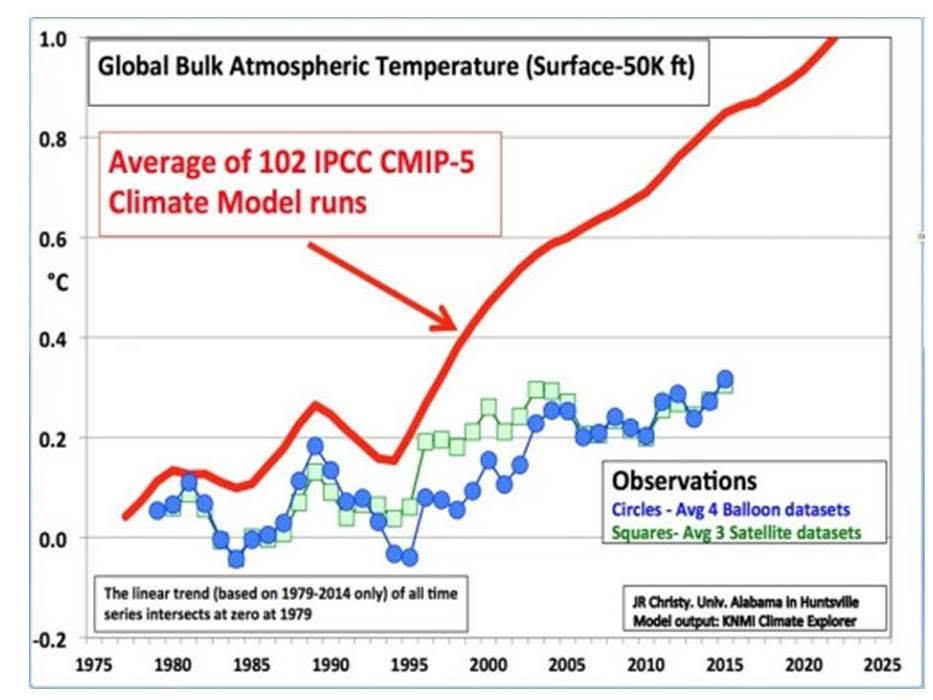Growing up, weather forecasts used to almost always give the percentage, say 20%, chance of rain. Now it doesn't seem so as frequent, but it's still part of the forecast--just not the reporting. Really, what is going on is that given current conditions, looking historically, 20% of the time it rained and 80% of the time it didn't.
Sadly, climate forecasts--especially by politicians--are presented as being extremely certain. So how do they actually measure up? There two ways to test them:
- Wait and see and then compare, and
- Take conditions we know existed in the distant past and them predict the "future" from that time to the present, and then compare them to the actual historical data. This latter method is often called "backcasting" as opposed to forecasting.
Fortunately, since the beginning of the man-made global warming claims and climate models started at least in the 90's, we have nearly 30 years of data to do both.
Forecasting:
John Christy, a renowned climate scientist, testified before the US House Committee on Natural Resources on May 13, 2015 about the accuracy of climate models. Part of his testimony can be found on YouTube here. He took 102 climate model predictions, averaged them and compared them to the climate actually experienced by 2015. Here's his graph:

Granted, there is debate on whether this is a fair representation (pro and con), but in each of the discussions of why it's inaccurate, it is admitted that there are "uncertainty ranges" in predictions (and measurements (see a prior post on How to Make Good Scientific Measurements). Those uncertainty ranges are for the predicted temperatures are more than half a degree. Look at the left scale on this graph. That's more than half the entire graph. That means the accuracy of "catastrophic scenarios" is very suspect. Here is a more detailed and updated representation of the graph above:
Simply put, graphs of our future temperatures are artificially (albeit scientifically) smoothed and averaged to make them appear to be more certain.
Backcasting:
Patrick J. Michaels in his book, Meltdown, does backcasting of two climate models from about 1993 back to 1905. In one model, says one economist reviewer, Thayer Watkins, "the backcast change in temperature was 96 percent higher than the observational change of the eighty eight year period. That is nearly a 100 percent error per century."
Additionally, if there are 102 models used, one would assume they are all different because of different assumptions--which is accurate. All models must include and omit real-world elements and disagree on small assumptions. The UN International Panel on Climate Change (IPCC) uses 22 models in its reports. If the science were "settled" then we shouldn't need 22 or 102 different models.
The Union of Concerned Scientists in one of it's articles says in defense of these models that they have gotten better in recent years and, "that the simulations accurately predicted the warming experienced in the past decade to within a few hundredths of a degree."
This is an absolutely astonishing statement by a scientist given that the direct measurements are no more accurate than 0.2 - 0.6 degrees, and any good high school teacher science teacher will tell you that scientific results can be no better than your least accurate measurement. The significant digits in this case can only be tenths of a degree--not hundredths.
To be clear, the argument here isn't that there is no warming, but how much how accurate are the predictions and are they sufficient to invest literally trillions of dollars that are being encouraged to be spent on mitigating this said crisis?
Additionally, if there are 102 models used, one would assume they are all different because of different assumptions--which is accurate. All models must include and omit real-world elements and disagree on small assumptions. The UN International Panel on Climate Change (IPCC) uses 22 models in its reports. If the science were "settled" then we shouldn't need 22 or 102 different models.
Additionally, climate scientists Patrick Michaels and Paul Kappenberger presented a paper that compared observed global surface temperature warming rates since 1950 to what was predicted by 108 climate models used by government climate scientists to predict how much carbon dioxide emissions will warm the planet.
What they found was the models projected much higher warming rates than actually occurred. “During all periods from 10 years (2006-2015) to 65 (1951-2015) years in length, the observed temperature trend lies in the lower half of the collection of climate model simulations,” the said, “and for several periods it lies very close (or even below) the 2.5th percentile of all the model runs.”
The Union of Concerned Scientists in one of it's articles says in defense of these models that they have gotten better in recent years and, "that the simulations accurately predicted the warming experienced in the past decade to within a few hundredths of a degree."
This is an absolutely astonishing statement by a scientist given that the direct measurements are no more accurate than 0.2 - 0.6 degrees, and any good high school teacher science teacher will tell you that scientific results can be no better than your least accurate measurement. The significant digits in this case can only be tenths of a degree--not hundredths.
To be clear, the argument here isn't that there is no warming, but how much how accurate are the predictions and are they sufficient to invest literally trillions of dollars that are being encouraged to be spent on mitigating this said crisis?


